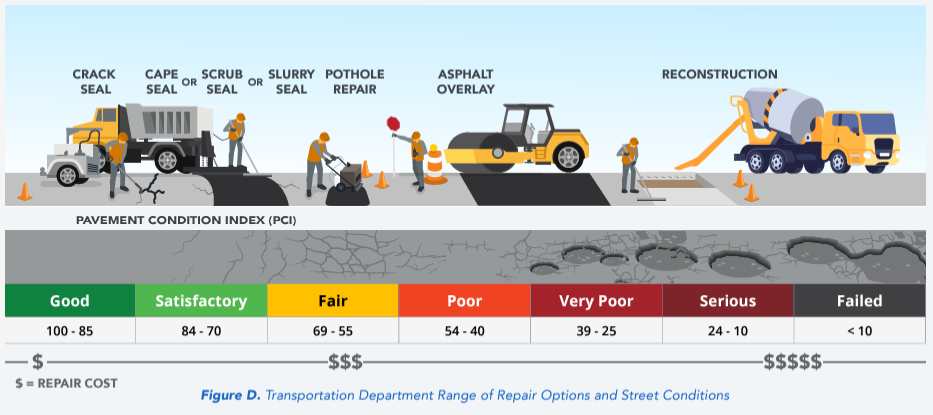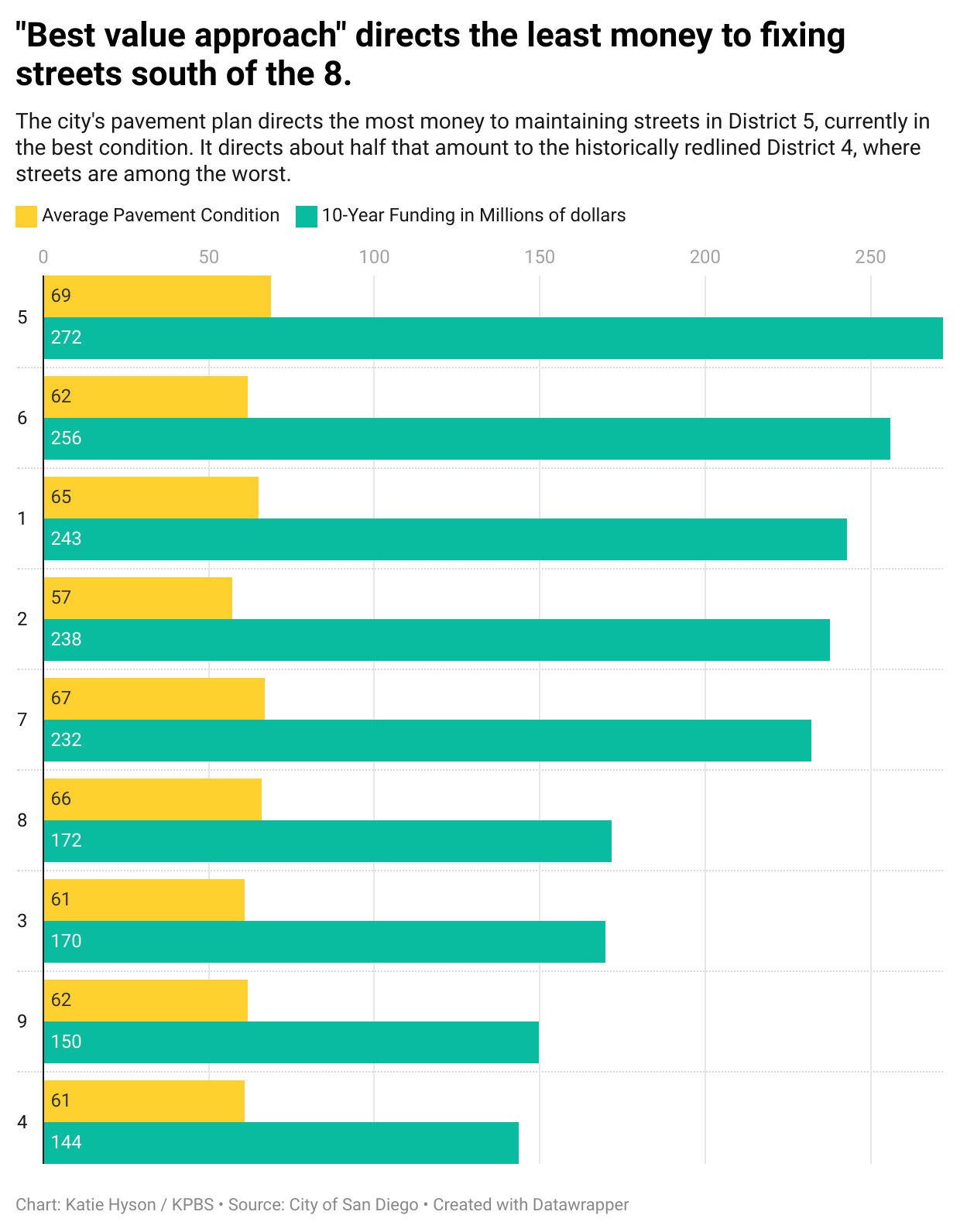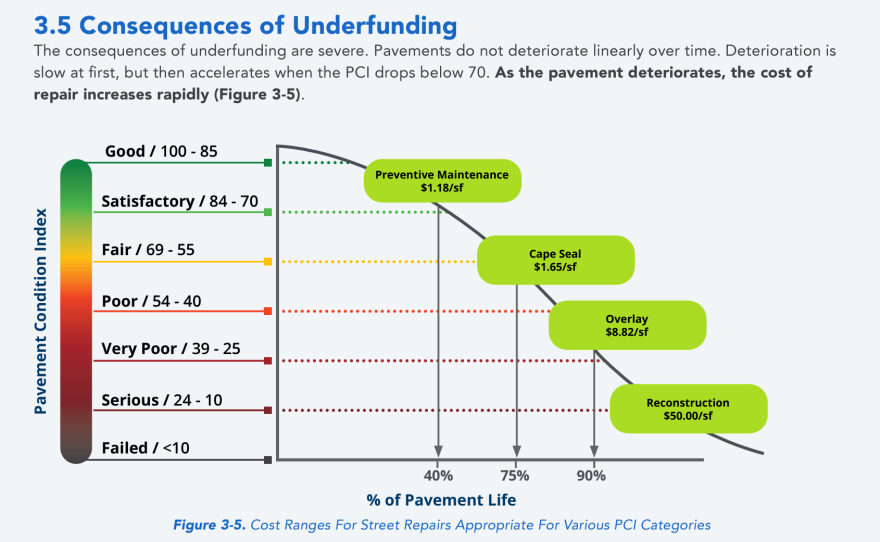The City of San Diego recently released a 10-year plan to improve the pavement of its streets. Though it rates the condition of streets in District 4 — including the neighborhoods of Encanto, Skyline and Valencia Park — as among the very worst, it directs the least amount of money to fixing them.
It advocates a “best value approach” — stretching limited budget dollars the farthest by improving the streets that aren’t as bad.
It would bring the city’s streets to a “satisfactory condition” overall, but it leaves behind District 4 — formerly redlined communities in Southeast San Diego with high concentrations of low-income Black and Latino residents.


“We have more potholes than you do bullet holes at our shooting range, and it don’t seem to bother our elected officials,” said Emerald Hills resident Evelyn Smith.
Encanto resident Aurora Valdez said the poor streets keep her from getting to class at San Diego State University.
Her car broke down — “I’m sure the streets didn’t help,” she said with a chuckle — and she’s been taking the bus. But because of closed-off streets in need of repaving, like 65th Street, she said sometimes the bus never comes. She said it forces her to use scarce money she might otherwise use for food to pay for Ubers.
Rob Campbell, who also lives in Encanto, called the poor pavement dangerous.
“Everywhere we go, if you try to walk, you know a sidewalk just suddenly ends and you're dumped into a street,” he said of streets like Klauber Avenue. “And the street is in such poor shape, kids can't ride their bikes. I can't push a stroller with a kid because the stroller wheels get stuck. And then with no sidewalk and cars barreling down, it becomes a very dangerous situation.”

It's dangerous not just for children, residents said, but for the neighborhood’s many elders and people who use mobility devices.
Valencia Park resident Andrea Hetheru said she’s seen people in wheelchairs hit the potholes and tip over.
District residents said they report issues through the Get it Done app, as the city encourages, but rarely get a response. And when they do, it’s not always what they hope.
Mauricio Zamudio from Skyline said the city repairs two potholes and leaves three open on the same street.
Or they close off streets for a long time, and when they reopen, pavement conditions seem to be worse.
Valdez pointed to 65th Street in front of Encanto Elementary, which she said reopened after being closed off for construction.
“Now there's a huge dip in the road, and cars go on the other side of the street to go around it,” she said. “This is all day. Everyone's doing it.”
Fixing roads is expensive. The worse they are, the more it costs, exponentially.
Preventative maintenance only costs $1.18 per square foot, while total reconstruction costs $50 per square foot.

Maintaining streets currently in good condition should prevent the city from needing the high-dollar investment failing streets would require in District 4, according to the city plan.
The city’s budget is stretched by competing demands, including much-needed storm drain repairs. And revenue is limited greatly by Proposition 13.
Passed in the late ‘70s, Prop. 13 put strict limits on the growth of property taxes. The longer someone owns a property in California, the more Prop 13 saves them money.
That means someone who bought a home 50 years ago shoulders much less of the tax burden for things like fixing roads than new homeowners.
Even if only large commercial properties were reassessed at their true market value, researchers estimate it could bring in as much as $11 billion in revenue for local governments in California.
The current revenue isn’t enough to improve all the streets in the city, so staff must choose.
The plan says the streets division worked with the City of San Diego’s Department of Race and Equity and factored equity into its decision-making process.
“They've included equity as part of the formula,” Hetheru said. “But somehow the way the numbers shake out, we always end up at the bottom.”

The formula also gives weight to roads that are close to “high use areas” like shopping centers.
Hetheru said District 4 roads are used less because the city has underdeveloped their district.
The plan directs the most money — nearly double the investment in District 4 — to wealthier District 5, rated as having the best streets.
“To me, it's the same game that they've been playing forever,” Hetheru said. “In one era, it was called desegregation. In another era, it was called affirmative action. Then it became diversity and inclusion. Then it became equity. It's just talk.”
District 4 was one of the worst hit by recent floods.
The water rose in minutes, but residents said the problem grew from decades of underservice by the city.

“It still feels like the community is redlined but now it feels like it's being redlined by the city and the county,” said Alta Vista resident Marry Young. “It just feels like we’re always waiting.”
“Somebody should be asking, ‘What does equity look like for the fourth district?’” she said. “‘And will it ever come?’ And if it's not going to come, then just stop talking about it and just say ... that you just have, you know, a concentration of poverty and that's where you put everybody. And then a few people will be able to get out. And that's how the world works. But that's not how I see it, you know?”

Young said when she gets off the 805, she’s home. She doesn’t think she’d feel that way anywhere else — even in the higher-resource areas.
She wants the city to deliver on its promises of equity to the community she loves. She doesn’t have another 60 years to wait.





